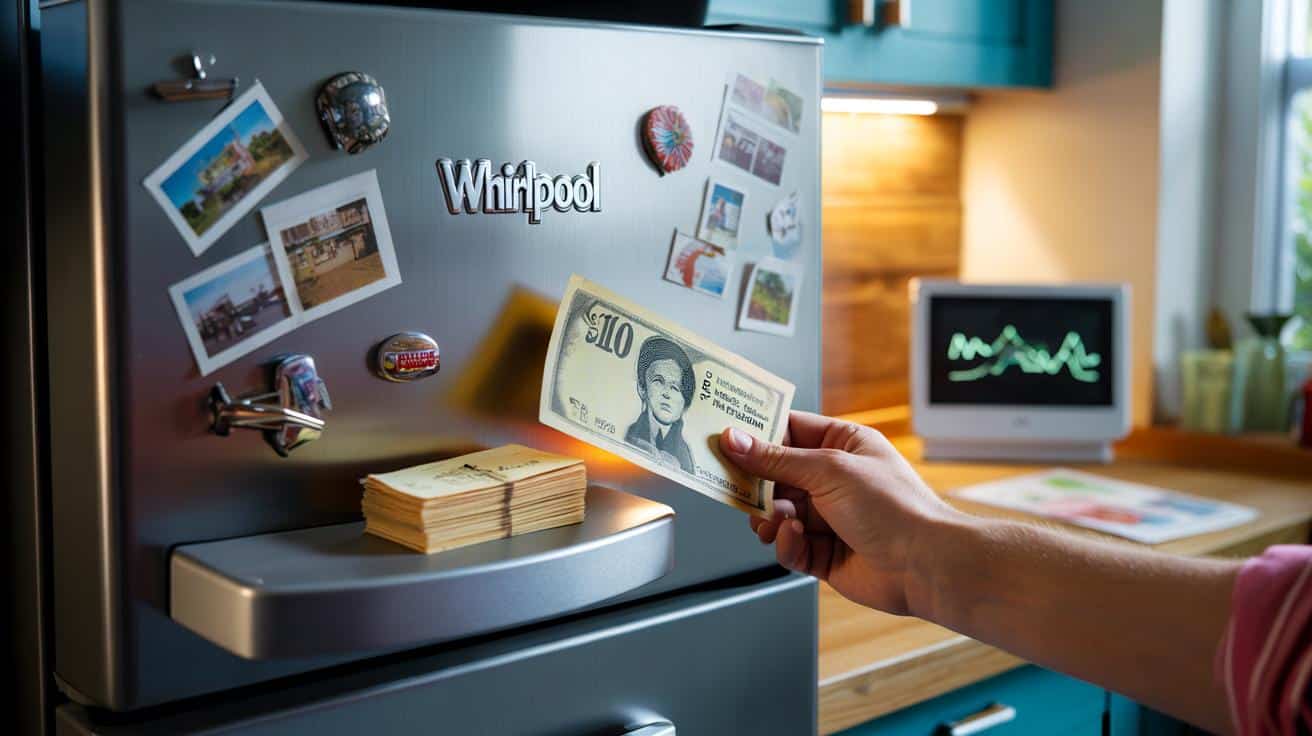A rumour says they nudge your electricity bill up. Whirlpool has now weighed in, and the answer tells a bigger story about what really costs you money in the kitchen.
The kitchen was quiet except for the soft hum of the fridge and a stack of bills whispering on the worktop. We stared at the door — a collage of alphabet letters, a postcard from Lisbon, the dog’s vaccination card trapped under a bottle-opener magnet — and joked that maybe this little gallery was secretly costing us pounds. *I ran my fingers along the cold metal and felt faintly silly counting magnets.* The joke landed, then it didn’t. Because the bill has stopped being funny.
Do fridge magnets really nudge your energy bill?
Short answer: no, not in any measurable way. Magnets clinging to a steel door don’t draw power, don’t create heat, and don’t force the compressor to work harder. Your fridge works to remove warm air every time the door opens, hold a stable 4–5°C inside, and push heat out via coils at the back or underneath.
There’s a more interesting twist. In a Manchester flat, a reader with a smart energy monitor took their magnets off for a week, then put them back on, recording hourly consumption. The line barely moved beyond the usual wiggles from door openings and the automatic defrost cycle. Fridge-freezers typically account for about 13% of a UK household’s electricity use, but that slice rises or falls with room temperature, thermostat settings and door habits — not with souvenir magnets.
So where did the fear come from? Two places: the magnetic door gasket, and the myth that extra metal somehow “loads” the appliance. The gasket already contains a magnet to seal the door; decorative magnets on the outer skin don’t cancel it or drain it. If anything, a light magnet far from the edge does nothing at all. Trouble starts when thick clips, stacked postcards or heavy novelty openers sit on the edge, create a tiny gap, and let warm air leak in. That’s not about magnetism. That’s about geometry.
What Whirlpool says — and what actually changes your bill
Whirlpool’s line is plain: decorative magnets don’t raise your bills unless they stop the door sealing or interfere with a sensor. That fits the physics and the field tests. Want a quick win you can do in minutes? Try the banknote test — trap a note in the door at several points and see if it slides out easily. If it does, clean the gasket with warm soapy water, check for crumbs, then test again.
Keep the set-up simple and boring: 4°C for the fridge, −18°C for the freezer, a couple of centimetres of space at the back for airflow, and tidy coils every six months. Place magnets away from the top corners and the door edge, and avoid chunky clips that ride over the seal. Store leftovers once they’ve stopped steaming, fill jugs with tap water to stabilise temperature swings, and resist browsing with the door open while you think about pudding. Let’s be honest: nobody really does that every day.
We’ve all had that moment where the bill lands with a thud and you start blaming the simplest, silliest thing. Here’s the calmer view Whirlpool nudged into the room:
“Magnets aren’t the villain. A clean seal, sensible settings and a clear back panel are where the money is.”
Try this quick weekend checklist:
- Do the banknote test around the entire door perimeter.
- Wipe the gasket and the mating surface; remove any stuck paper under magnets.
- Slide the fridge forward, vacuum the coils and check for 2–5 cm of clearance.
- Shift any strong magnets away from top corners where door sensors may sit.
- Set the fridge to 4°C and leave it there for a week.
A cooler take to share
The Whirlpool statement knocks down a tidy myth, yet the bigger story is how we hunt for culprits we can see. Magnets are visible. Air leaks, temperature drift and dusty coils are not. A fridge draws steady, modest power when it’s well set, sitting level, and closing with a gentle thud. It gulps energy when warm air spills in, the room runs hot, or frost builds on the evaporator like a jumper.
That makes this a hopeful topic, not a scary one. You don’t need to strip your door bare or ban holiday keepsakes. You just need to give the seal a fair shot, keep strong magnets and thick paper stacks away from the edge, and let the machine breathe. The little savings add up not because of a gimmick, but because you’re removing friction the fridge can’t talk about. Pass that on to a friend who’s glaring at their bottle-opener magnet right now.
| Point clé | Détail | Intérêt pour le lecteur |
|---|---|---|
| Magnets vs. energy use | Decorative magnets don’t draw power or heat; only matter if they lift the seal or confuse a sensor | Stop worrying about souvenirs, focus on the seal and sensors |
| Where the money goes | Door openings, warm rooms, thermostat settings, dirty coils and poor airflow drive consumption | Targets the habits and fixes that actually cut bills |
| Simple weekend checks | Banknote test, gasket clean, coil vacuum, 4°C setpoint, clear space behind | Actionable steps with quick, measurable impact |
FAQ :
- Do fridge magnets increase electricity bills?Not on their own. They only matter if they physically interfere with the door seal or a door sensor, which can let warm air leak in.
- Can magnets damage the door gasket’s magnet?
No. The gasket’s strip is permanent and separate. Light decorative magnets outside don’t drain or cancel it.
- Is there any risk with strong neodymium magnets?Keep them away from the top corners and the seal edge. Very strong magnets could trick a reed sensor or pull paper across the seal.
- What’s the quickest way to check my seal?
Use the banknote test around the full perimeter. Clean the gasket and frame, then repeat. Replace the gasket if the note slips everywhere.
- What changes will actually lower my fridge costs?Set 4°C, keep coils clean, give it breathing room, cool leftovers before storing, and reduce idle door-open time.








